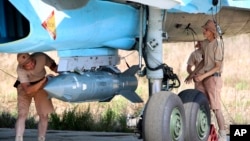Russian intervention in Syria appears to have shored-up President Bashar al-Assad’s hold on power, but the latest U.S. assessment indicates slickly produced videos meant to show off Moscow’s military actually are covering up what might be difficulties both in the air and on the ground.
“While the front lines may move in favor of the regime in the near-term, retaining any newly re-gained territory will be a hard task,” a U.S. intelligence official told VOA on condition of anonymity.
So far, most of the gains from the Russian-backed ground offensive have come in the northwestern part of Syria, where Russian airpower has supported a mix of forces loyal to Assad along with some Shi'ite militiamen from Iraq and Iranian forces.
As pro-Assad forces have moved further inland, however, contesting rebel forces in and around cities like Aleppo, Homs and Hama, they seem to have stalled.
FSA claims
In the Hama countryside, rebels with the moderate Free Syrian Army claimed to have destroyed more than 20 regime tanks, while shooting down three helicopters despite running low on supplies.
“Many of the [rebel] forces that remain in key areas are battle-hardened and experienced fighters,” the intelligence official said. “Air power alone is unlikely to turn the battlefield in Assad’s favor.”
And while the U.S. says most of the Russian airstrikes have targeted moderate opposition groups, more radical groups like the Islamic State, Jabhat al-Nusra and Ahrar al-Sham are lurking.
Russian officials have dismissed such criticisms.
On Friday alone, the Russian Defense Ministry said its combat jets hit 60 Islamic State targets in Syria over a 24-hour period, killing about 300 militants using precision-guided bombs. And the ministry’s social media accounts have issued a constant stream of videos showing Russian planes destroying targets on the ground.
“Russia is trying to showcase the operations in the same way the US does so they can shape a perception as being as capable as the US in conducting these types of operations,” said Sim Tack, a military analyst with the Stratfor global intelligence firm.
Underwhelming performance
But Tack said the reality of the Russian-led campaign has failed to live up to its billing.
“They are facing severe resistance on the ground and I would dare to say that with the amount of destroyed vehicles that we’ve seen, this might be a setback in the early stages of that offensive,” he said. “This is looking like a quite effective defense of operation from the [Syrian] rebel side.”
Human rights groups also have been quick to point out high numbers of civilian casualties associated with many of the Russian air strikes, charges that Russian officials have steadfastly denied.
U.S. officials also said this past week that four of the first 26 cruise missiles launched by Russian warships in the Caspian Sea failed to reach their intended targets in Syria, crashing instead in Iran.
Again, Russian officials rejected the allegation.
Some analysts warn, however, the Russian campaign on behalf of the Assad regime should not be underestimated.
“A couple of weeks ago the Assad regime was under real pressure,” said Salman Shaikh, a former United Nations diplomat who now heads The Shaikh Group.
“I certainly heard from Damascus, even people from within the security forces, senior generals, contacting people and wondering what was the safest route for themselves out of Syria and ways to protect their families,” he said. “Now all that has been reversed.”











